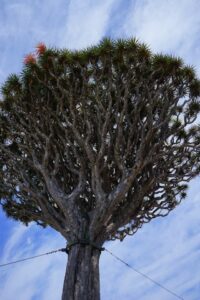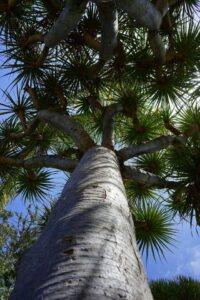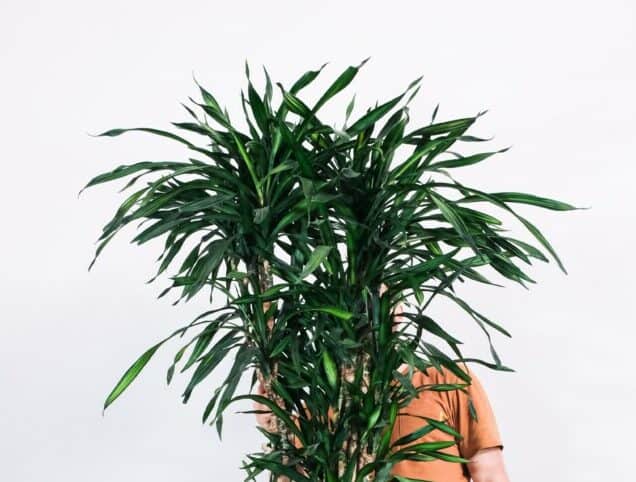Some links in the post are affiliate links and I get a commission from purchases made through some links found in the post.
I’ve watched the Penguins of Madagascar countless times, and the movie never ceases to amaze me.
So, I figured that one day, I would take a trip down to this magnificent island and enjoy the sun, warm breezes, and tropical vibes. But alas!
With COVID 19 bringing the world to an almost halt, I had to rethink my travel plans. But what could step in and fill this void I eagerly wanted to meet? Well, the Dracaena Marginata!
This plant, native to the tropical forests of Madagascar, was as close as I could get to the island. And I was intent on making the most out of it.
But first, I had to learn what kind of potting mix it needed (it turns out there’s a lot more to this tree than I expected).
A dracaena marginata needs loamy, well-draining soil using a potting mix 1/3 loam, 1/3 pumice or vermiculite and 1/3 peat.
The soil should be neutral to acidic ranging from Ph 6 – 7. Given that it grows in a tropical region, it has made do with nutrient-poor soils owing to all the rain.
The one thing it cannot stand is waterlogging, as this is a one-way ticket to root rot.
I cover what you should look for in a potting mix, touching on my favorites, and how you can know that your plant needs a bit more TLC:
What Soil Nutrients Does a Dracaena Marginata Need?
If you want to glaze over the whole nutrient profile and get straight to the basics, here we go. Your plant needs nutrient-rich soil with good drainage. And you can achieve this by combining:
- One part of loam,
- One part of pumice (vermiculite is a good alternative), and
- One part of peat.
That’s all it takes. Mix these components, and you will have the perfect potting mix for your Dracaena Marginata.
But that does not address the nutrients your plant needs to thrive. And without knowing these, you are bound to deprive it of essential nutrients – which you do not want to do. So, what does it need?
In the wild, the plant gets its nutrients from the surrounding soil. But indoors, it heavily (solely) relies on what it can get from the potting mix. The ideal potting mix should comprise:
1) Macronutrients
If you look at what commercial fertilizers contain, you will come across mineral nutrients divided into macronutrients and micronutrients.
Nitrogen, potassium, and phosphorus are good examples of vital macronutrients that aid in the formation of healthy stems, roots, and leaves.
They also boost plant growth and are the best go-to options when a plant experiences stunted growth. You can also get these nutrients from organic matter like compost, coffee grounds, leaves, moss, etc.
2) Micronutrients
These are nutrients that plants need in smaller quantities. That does not make them any less important, as they come in handy in vital plant processes.
However, the Dracaena Marginata is not too specific about these nutrients. They include calcium, iron, chlorine, copper, magnesium, nickel, and calcium.
Thus, you are safe going for a balanced NPK formula when feeding your plant. Alternatively, you can choose the organic route and bank on organic houseplant mixes, as I will cover later.
You may also like: Dracaena marginata light requirements
What Type of Soil Should You Use for Your Dracaena Marginata?
To understand the best soil for your plant, you need to get to know it a bit better. The Dracaena Marginata is a tropical plant (tree) native to the island of Madagascar.
It’s easy to care for if you can replicate its growing conditions on the island. Generally, it is quite resistant to dry conditions.
If you know a bit about Madagascar, you know that the island has some hot and dry regions.
And the Dracaena Marginata thrives in these areas. So, you can imagine that this hardy tree has roots developed to withstand such conditions.
That’s why you are better off leaving it underwatered rather than overwatered – not that I am advocating for this. But if you must choose between these evils, go with underwatering as it is easier to fix.
When it comes to soil, this plant is not too selective. In most cases, it survives in nutrient-poor soils and will not make much of a fuss about it.
But if you want it to do well, you should always go with a balanced nutrient profile as this encourages prolific growth and helps the tree ward off pests and diseases.
Soil Drainage
 What affects drainage in a potting mix? It’s all about the texture of the soil. Take sand as an example. It has large particles which pave the way for huge air pockets that allow water to flow freely through the spaces.
What affects drainage in a potting mix? It’s all about the texture of the soil. Take sand as an example. It has large particles which pave the way for huge air pockets that allow water to flow freely through the spaces.
And we all know that clay has a low water retention rate and is not the best main component for a potting mix. Clay, on the other hand, is too compact owing to its small particles, which barely leave enough space for water to flow.
That’s why loam is the best option for the Dracaena Marginata, which cannot withstand sitting in soggy soil.
It has a medium texture that balances water passage and air entry, essential for healthy root development. But loam in itself is not enough for this tropical tree.
Again, we must remember that it thrives in a tropical climate where drainage is key.
We thus recommend using a balance of sand and loam, mixing in equal parts of the two. Such a mix will have medium to high drainage properties with a good balance of nutrients.
To be on the safe side, you should also add organic matter. It boosts the nutrient profile in the soil and also improves drainage.
Compost is a good idea. However, you should add it in small amounts as too much compost can increase water retention and trigger root rot. Other organic material ideas include shredded bark and coco coir.
What Are the Signs You Are Using the Wrong Soil For Your Dracaena Marginata?
Plants are rarely shy in expressing their displeasure, and the Dracaena Marginata is not an exception. If you do not afford it the care it needs, it shows signs of neglect. And this can result from many things, including:
1) Using a Highly Draining Potting Mix
If the soil drains all or almost all the water you give the plant, the Dracaena Marginata will end up dehydrated. And its leaves will appear wilted, yellowing/ browning, and the plant will appear weak.
If you notice that the plant droops and the soil surface is dry even when on a regular watering schedule, the potting mix could be too aerated.
2) Using a Compact Potting Mix
If the potting mix does not have sufficient drainage, it will hold on to water, causing waterlogging, which will drown and damage the roots.
A waterlogged Dracaena Marginata shows yellow leaves, suffers stunted growth and develops a soft stem. Moreover, its potting mix may emit a foul smell and will appear wet.
In such a case, you will need to cut off the damaged roots and cut back on watering. If the problem persists, you will need to repot the plant.
3) Underfeeding the Plant
While the Dracaena Marginata is not too specific about feeding, it does not appreciate getting minimal nutrients. You must remember that it has no other source of nutrients other than the potting mix.
And when it depletes these reserves, it shows signs of stunted growth, dropping leaves, leggy growth, and browning.
The plant can also droop as it does not have sufficient energy to maintain its growth. While it will not necessarily die, its aesthetic value will suffer.
4) Overfeeding the plant
Too much fertilizer can damage the Dracaena Marginata’s roots, curbing its ability to absorb nutrients and water from the soil.
When this happens, the plant’s leaves start yellowing, its growth slows or halts, and the plant appears weak. It will also be more vulnerable to pest infestations in this state.
You will notice a mineral build-up on the soil surface in some cases. To fix this, you need to flush the potting mix with water. And if the plant does not show any signs of recovery, you will need to repot it to save it.
Have you noticed such signs in your Dracaena Marginata? It might be time to change your choice of potting mix.
If you’re enjoying this article, check out our article on how to care for a dracaena outdoors.
What PH Should the Soil Be for A Dracaena Marginata?
Does pH matter when making a potting mix for this tropical plant? The answer is yes! pH is the measure of alkalinity or acidity in the soil.
Some plants thrive in acidic conditions, others prefer neutral soils, while others do well in alkaline soils. So, what works for the Dracaena Marginata?
Anything between 6 and 7 is a good option. Such a level is mostly neutral with slight acidity. If your soil does not meet this specification, you can always amend it by adding acidic or alkaline components.
For example, if your soil lies on the alkaline side, you can add coffee grounds to make it more acidic.
Or, if it lies on the acidic side, you can add some crushed eggshells to make it more alkaline. Play around with organic components to reach the 6-7 balance.
Our 5 Recommended Soils for A Dracaena Marginata
Making your Dracaena Marginata potting mix is always a welcome choice. But if you want to get a ready mix that’s perfectly balanced for your tree, we recommend the following options:
1) Gold Premium Potting Soil
This potting mix comprises organic materials, so you can rest assured that you are not introducing any synthetic components to your home.
Besides, using it is easy, and you can pour it into your pot straight from the packaging. Plop your Dracaena Marginata into the mix, add some water, and you are good to go.
2) Roots Organics Rod Soil Original Potting Mix
This mixture is rich in essential composted organic matter that allows your plant to thrive.
Moreover, it features components that facilitate good drainage, including perlite and pumice.
3) Miracle-Grow Houseplant Potting Soil
Texture is everything for the Dracaena Marginata. And in this case, you get a loamy texture that paves the way for adequate drainage.
I should also add that this mix features a wide range of macro and micronutrients that can last your plant up to half a year.
4) FoxFarm Ocean Forest Potting Organic Mix
pH is a deal-breaker for the Dracaena Marginata. This mix features potting mixes with ranges between 6.3 and 6.8, which is what your plant needs to thrive.
And as the name suggests, the organic materials in play in this mix are like what you would find in the forest.
5) Burpee Organic Premium Potting Mix
Do you know the benefits of using coco coir in any potting mix? By now, it’s not a secret that the Dracaena Marginata does not enjoy waterlogging.
Well, coco coir is ideal for retaining moisture while preventing waterlogging. It’s the kind of balance your tree craves.
See anything that catches your eye? Let’s learn a bit more about our beloved tropical tree:
Can I Use Cactus Soil for Dracaena Marginata?
Most cactus soil mixes do not provide adequate moisture and nutrients and are thus not suitable for the Dracaena Marginata. You should opt for houseplant soil mixes like the ones discussed above.
If you must use cactus soil, we recommend that you amend it with peat moss as this will increase its nutrient profile and improve its drainage, which will be beneficial to your plant.
You may also like: How to save a dying dracaena marginata plant
How To Repot A Dracaena Marginata
 Luckily, the Dracaena Marginata needs repotting every two to three years. You can even push it a bit if the plant is not rootbound and repot the plant in four years.
Luckily, the Dracaena Marginata needs repotting every two to three years. You can even push it a bit if the plant is not rootbound and repot the plant in four years.
However, your plant needs immediate repotting if it has suffered root damage or is rootbound. So, how do you do it?
- Choose a season when the plant is actively growing as this reduces the repotting stress. Your Dracaena Marginata may take a while to recover from the change,
- Cut off the damaged plant parts, e.g., soggy roots, using sterilized cutting tools,
- Select a pot that is one size bigger than the current one – Don’t go for a much bigger pot as this encourages waterlogging,
- Fill the pot with a suitable potting mix, and
- Plant the Dracaena Marginata in the potting mix and soak the soil with water, allowing the excess to drain through the pot’s holes.
Your work is done!
Final Thoughts
As I dream of the day I can finally land in Madagascar, I will continue to moderately water my Dracaena Marginata and learn more about what makes it thrive. Happy Gardening!
Before you go, here are some more related articles I encourage you to read below to help solve more of your gardening issues:







